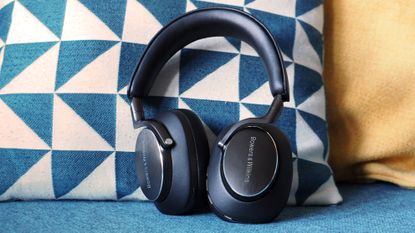Fresh from this summer’s success with the extremely well-received PX7 S2 wireless over-ear noise-cancellers, Bowers & Wilkins is back with what looks suspiciously like more of the same in the PX8.
Despite the superficial similarities with their PX7 S2 siblings, though, the PX8 are intended to be an across-the-board improvement – and in every respect, from aesthetic to sonic – and a contender for the best headphones money can buy.
So can lightning strike twice? And, more importantly, can it strike a second time in what is a significantly more expensive neighbourhood? I've been wearing the Bowers & Wilkins PX8 for a number of days now, and here's my in-depth review of what are (spoiler alert) truly exceptional headphones.
Bowers & Wilkins PX8: Price and release date

The Bowers & Wilkins PX8 are on sale now, and in the United Kingdom they’re yours for £599. American customers will have to part with $699 (which seems a rather quaint rate of exchange these days). In Australia they sell for AU$1149.
A company has to go some to make Apple’s AirPods Max seem aggressively priced, but that’s exactly what Bowers & Wilkins has done with the PX8. And given the number of extremely capable noise-cancelling over-ear headphones we’ve heard that cost little more than half of this money, Apple is far from the only brand Bowers & Wilkins needs to leave in its wake if the PX8 are going to make any sense.
Bowers & Wilkins PX8 review: Features & what's new?
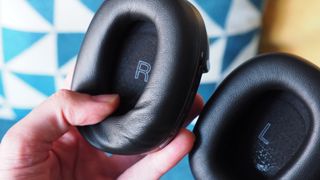
The PX8 use Bluetooth 5.2 for wireless connectivity, and they are compatible with Qualcomm’s aptX, aptX HD and aptX Adaptive codecs – which is uncomplicatedly good news. Well, it is for anyone who’s not using an iPhone as a source player, anyway – although it’s at this point I ask why you’re using a codec-poor smartphone with £599 headphones anyway?
Once it’s streamed on board, sound is delivered via a pair of new 40mm full-range Carbon Cone dynamic drivers. Bowers & Wilkins has taken its learnings from the Carbon Dome drivers it developed for its acclaimed 700 Series loudspeakers and miniaturised it, basically. The Carbon Cone driver is designed for super-fast response and ultra-low distortion, and they’re very specifically angled inside the earcups to ensure they remain a consistent distance from the wearer’s ears at every point.
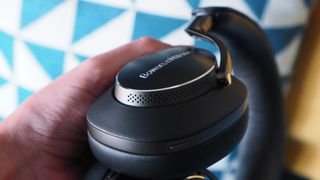
The PX8 use the same active noise-cancelling (ANC) platform as that fitted to the PX7 S2 – which is a sensible move, given the PX7 S2 are among the more effective noise-cancellers around. So like the PX7 S2, the PX8 limit your ANC options to ‘on’, ‘off’ or ‘pass-through’, and like the PX7 S2 they don’t alter their sonic characteristics in the slightest no matter which of those options you choose.
The PX8's battery life of 30 hours (with ANC switched on) isn’t too bad at all, even if it’s giving away a few hours to the class leaders. The introduction of quick-charging is very worthwhile, though – just 15 minutes of mains power is good for around seven hours of playback.
Bowers & Wilkins PX8 review: Performance

Is it a spoiler to start by saying the PX8 sound great? Or, given the brand and the price involved, were you expecting that anyway? Little in the world of consumer electronics is a certainty, of course, but Bowers & Wilkins headphones at £599 a pair would seem to be as close to a certainty as we’re likely to get.
Anyhow, that’s the headline here: the PX8 sound great. And they sound great in pretty much any circumstance, with any type of music, at any volume level and in any environment. They’re a deeply accomplished pair of headphones, as I suppose the asking price insists they should be.
It’s true they can turn their hand to anything. A massed symphony orchestra, a sensitive singer-songwriter with just one instrument accompanying them, a lap-top savant whose music has never been anywhere near an actual musical instrument, dance-floor punishers, indie rockers, you name it… the Px8 like it all, and they handle it all with aplomb.
The low frequencies the Bowers & Wilkins can generate are very deep, hit impressively hard, are beautifully shaped, packed with detail both broad and fine, and controlled so completely that they never even hint at dragging at a rhythm or a tempo. The bottom end fairly motors along here, underpinning everything above it, but never sticking its oar too far in.
At the opposite end, treble sounds have authentic bite and plenty of shine to them - but they’re substantial, rather than airy, and they resist hardening up even at significant volume. They attack with just as much determination as the low frequencies but, just as with the bass reproduction, the top end is properly controlled and never suggests it’s going to leave its lane and become in any way unruly.

In between, though, is where the PX8 keep the most generous portions of their eloquence. Midrange information is absolutely loaded with information, both broad and fine, regarding tone, timbre, texture and, in the case of vocalists, technique and character too. Communicative to an almost indecent degree, these Bowers & Wilkins headphones will make you realise a singer you thought enjoyed pretty sound technique is, in fact, right on the edge… if there’s attitude or emotion to be revealed in a vocal line, the Px8 will hand it over in full.
The frequency range is smoothly integrated from top to bottom, and tonality is utterly convincing. The PX8 create a big, properly organised soundstage, so even large ensembles or complex mixes are easy to understand. They have the sort of vaulting dynamic ability that can put considerable distance between ‘loud’ and ‘quiet’, but they’re just as attentive to the dynamics present in the harmonic variations when you’re listening to, say, a solo piano. They identify the finest details and bring them to the listener’s attention – not in a showy way, but in proper context.
So yes, it’s probably best to finish as I started: by saying the Bowers & Wilkins PX8 sound great.
Bowers & Wilkins PX8 review: Design
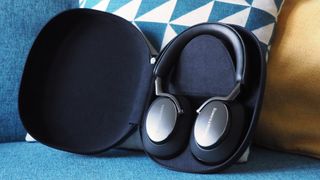
Yes, a casual glance at the PX8 doesn’t give any explanation as to why they’re so much more expensive than their PX7 S2 relatives. Get just a little closer or spend just a little longer, though, and the differences become apparent: as pointed out in our PX8 vs PX7 S2 feature.
The PX8 can be had in two finishes: black, or tan and grey. No matter your preference, Bowers & Wilkins has specified soft, hard-wearing and nicely tactile Nappa leather to cover the inner and outer parts of the headband, as well as the memory foam of the ear cushions. It’s beautifully applied, looks and feels the part, and along with an all-in weight of just 320g it helps the PX8 remain comfortable in situ for hours on end.
Elsewhere, the headband adjustment mechanism and arm structure are made from cast aluminium, and the edge of the logo plate has a bright, diamond-cut edge. So no, the visual differences between the PX8 and the PX7 S2 aren’t extensive, but they’re significant. Certainly they go some way towards justifying the additional outlay – have a look at my review of the Mark Levinson No.5909 wireless headphones and you’ll see what I mean. Those headphones cost £999, but they’re not as well-realised or desirable an object as the PX8.
As with the PX7 S2, the PX8 goes without touch controls, relying instead on some nicely implemented physical control buttons, access to your source player’s native voice-assistant, and the recently spruced up Bowers & Wilkins Music control app.
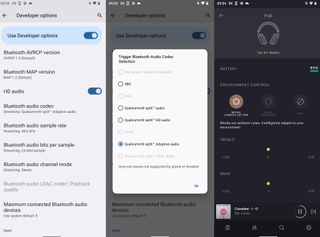
The right earcup features a slider for ‘power on/off/Bluetooth pairing’, and a three-button array. Two of them take care of ‘volume up/down’, while the third looks after multiple functions: ‘play/pause’, ‘skip forwards/backwards’ and ‘answer/end/reject call’. There’s also a USB-C input here, available for charging the battery or making a physical connection to a source player (Bowers & Wilkins includes a couple of 1.2m cables in the headphones’ carry-case, one USB-C/USB-C and one USB-C/3.5mm analogue). Bear in mind the PX8 must be switched on even when being hard-wired to a source.
On the left, meanwhile, there’s a single button that can either cycle through your noise-cancellation options or summon your player’s voice-assistant. You can decide on the function you’d prefer in the Music app.
In addition, the app allows some EQ adjustment, lets you examine your ANC options and all the other usual app stuff – look for software updates, check battery status, that kind of thing. But now it’s possible to integrate your favourite music streaming service (as long as it’s Deezer, Qobuz or Tidal) and stream music directly from the app. This is good news, obviously – it means you only need one app open in order to enjoy your music. The app isn’t absolutely glitch-free right now, it must be acknowledged, but it’s generally stable and always logical, and as good as or better than any alternative that doesn’t say ‘Apple’ or ‘Sonos’ somewhere.
Bowers & Wilkins PX8 review: Verdict

Delivering a product that looks, to all intents and purposes, like a £379 product and charging £599 for it is a bold strategy. But Bowers & Wilkins has made a sufficient sonic upgrade with the PX8 to make the price difference between it and the PX7 S2 (itself an extremely capable product, let’s not forget) seem entirely reasonable.
So if you’re prepared to spend big on a new pair of headphones, but want to hear as well as see and feel where all that money has gone, you need to check out the Bowers & Wilkins PX8. These are exceptional headphones in every regard.
Also consider
It comes to something when your headphones can make alternatives from Bang & Olufsen look like a bit of a bargain, but suddenly the Beoplay HX seem like a steal. They’re just as desirable an object as the PX8, just as elegantly understated, and they’re a similarly vivid, articulated listen. They don’t have the noise-cancellation chops of the Bowers & Wilkins, though, and incredible as it may seem, they don’t feel quite as luxurious either.

